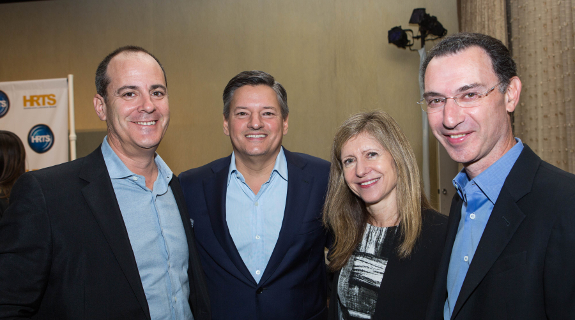Top Hollywood programmers extolled—and didn’t shy away from—the virtues of “peak TV,” as FX’s John Landgraf famously said last summer. In fact, right now is “the best time ever to make television,” said ABC Entertainment President Paul Lee at the Hollywood Radio and Television Society’s annual State of the Industry luncheon in Beverly Hills on Thursday.
With an ever-expanding glut of original content and the ever-shifting changes in distribution models, technology and social media, there’s a lot to discuss, obsess over and worry about. Given that, maybe it should come as a surprise that this afternoon showcased a positive outlook on the future of TV. This bright disposition is thanks to international demand and the continued globalization of content, the diversity on screen and behind the scenes, and more and more networks keying in on online distribution.
Or maybe it’s as simple as more people watching more TV than ever, providing fodder for the panelists to discount Landgraf’s “too much TV” proclamation.
“There’s no such thing as too much TV,” said Ted Sarandos, Chief Content Officer, Netflix. “That is an extremely old lens to look at TV under. Unless we’re all spending more and not watching more. That’s not the case. The number of television [hours] we’re watching is growing dramatically.”
“But now when you can open the world to different kinds of storytelling and storytellers, the potential is unlimited,” said Sarandos. “This is the largest explosion of TV production in history.”
“It’s not about how many shows, but how many great shows,” said Lee.
“It doesn’t create a glut of programming but an opportunity for the best, most beloved shows to arise,” said Sandra Stern, President, Lionsgate Television Group.
“Right now is a time when you take a risk. When I don’t take a risk, it doesn’t work. When I go for it, it works,” said Lee.
Even so, branding is as important as ever.
“You can be a broadcast network and a brand. Now in a world of fragmentation, it’s a brand that makes you stand out,” said Lee.
Showtime has addressed this issue head-on, a necessary move given its recent expansion to Canada and online.
“We’re going to be in an app-based world,” said David Nevins, president, Showtime Networks Inc. “We’ve always had an issue of attribution of our shows. It’s been an issue in the US, a bigger issue internationally; what do Homeland, Dexter, Ray Donovan and The Affair have to do with each other?”
“I think we’re getting more and more brand attribution in the US, and it’s starting to get stronger in Canada. Certainly in the English speaking world, Showtime is starting to mean something,” said Nevins. “We’re trying to put the pieces together so our brand starts to mean something around the world.”
CBS/Showtime’s pact with Bell Media is seen as the harbinger, generating a lot of interest in the international market, according to Nevins. “The addictive serialized storytelling that we do is what’s driving the market in a lot of places. The same dynamics happening here are happening around the world.”
It also helps to have the organic buzz of David Lynch’s forthcoming Twin Peaks revival.
“The value of Twin Peaks enforces the importance of that brand,” said Frances Berwick, President, Lifestyle Networks, NBCUniversal Cable Entertainment. “Brand is really important right now. It will be vital in a couple years’ time.”
“Brands have to speak for themselves. If we go to that network or that app, we have to know what to expect. Our survival will depend on our audience having that connection and that the brand promise is delivered on,” said Berwick.
“You need to create a loose direction and brand promise, and then let showrunners [have their vision]. Unless they’re loving it, taking risks, breaking rules, they’re never going to create storytelling that people will break down walls to get to,” said Lee.
On the other side of the spectrum, Showtime is breaking down walls to get to viewers after launching their online streaming service.
“It’s clearly what’s going to drive our growth going forward,” said Nevins. “I thought it’d be a small locus of focus for the first year or two and it’s become a major part of who we are, very fast.”
According to Sarandos, this is necessary. Networks must go to the consumer, and not the other way around.
In September, Netflix brought their content to Japan, a notoriously difficult market to break into, to great success.
“Content from Hollywood travels really well,” said Sarandos.
Social media has likely facilitated that process.
“Social media is a fantastic boon to TV,” said Lee. “It’s a wonderful thing not watching TV off alone in the dark, [and instead] watching with millions of people.”
Despite traditional TV ratings being lower than they were a decade ago, Lee believes the conversations surrounding popular programming, such as ABC’s #TGIT, are greater than the ones being had 10 years ago. In turn, that social buzz is driving shows’ popularity, which is being seen across platforms.
Social media, along with endless distribution models, has made it necessary to look beyond just the Nielsen ratings. And not just for Netflix, but for everyone.
“Five to 10 years ago, broadcast was a single revenue stream. It was all about the show brand,” said Lee. “Over the past five years, [TV has been] built into multiple revenue streams.”
“I gave crap to [Sarandos] 2 years ago, but now I’m in his business,” said Nevins.
Showtime isn’t alone.
Everyone’s in the streaming business, and thanks to the rampant globalization of content, that business is good.
Tags:













































__twocolumncontent.jpg)











